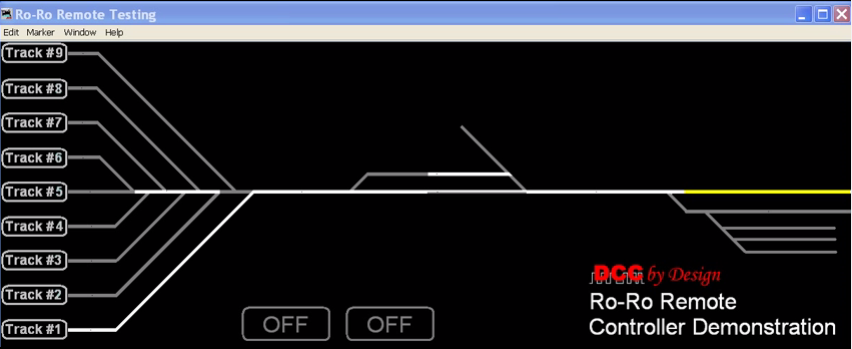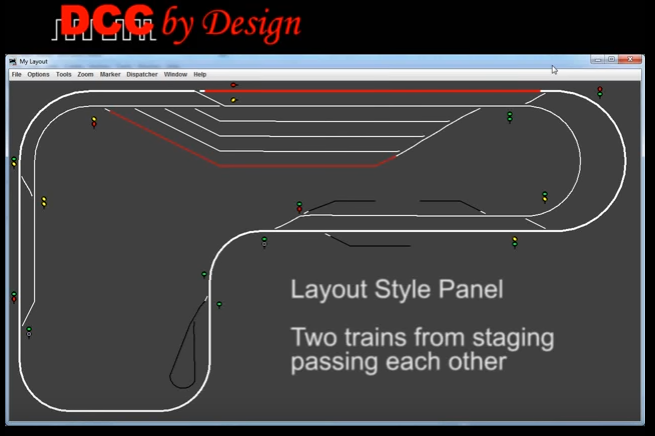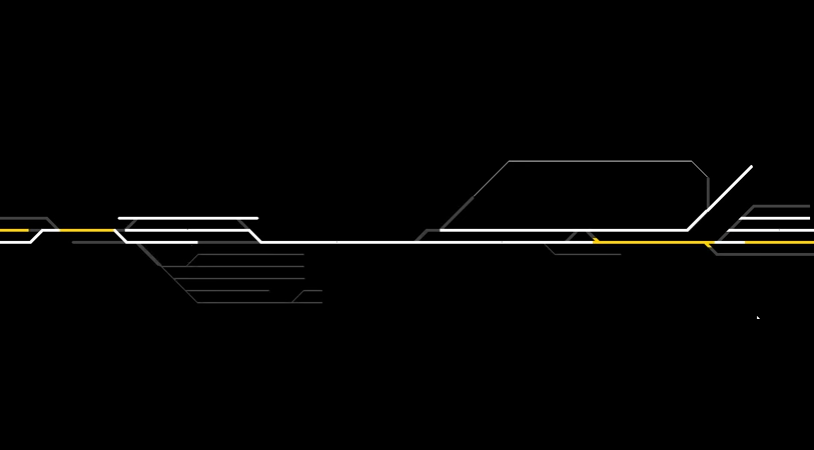First, a quick review. This article assumes that you have already selected at starter system from on of the major DCC vendors as outlined in Article 1 Early Decisions & Starter Sets. Also, if you have not already done so, I suggest that you convert or buy a few DCC locomotives (see Article 2 Choosing Mobile Decoders). Assuming these two steps are completed, the next step is to control your turnouts with stationary decoders.
This article and the others on this site provide basic information to educate DCC consumers. DCC by Design offers the service of designing a DCC system for you. As part of our Design Services we will work with you to examine your needs, address the issues below and many, many more. Then we convert your preferences, layout design, and budget into a complete DCC system.
We offer this free information as a small sample of how we can help you with our Design Services. Drop us note so we can discuss with you improvements for your current or design for your next layout.
Operating Turnouts DCC or other methods
Turnouts can be controlled manually (such as ground throws), direct electrical control, or by DCC. As with controlling locomotives, using DCC to control turnouts offers significantly more options and flexibility than using direct electrical control. Turnouts are controlled with stationary decoders.
There are two major categories for operating turnouts direct or DCC
- Direct means that the control is hard wired to turnout driver:
- Manual - Ground throws used to operate turnout without electricity
- Elec. Switch – Switch is hard wired to stationary decoder such as DS54 or SE8c.
- DCC means that the command is sent from the control to the turnout driver by the DCC command station. There are three differ ways for the operator to send the turnout commnads.
- Throttle based – Throw all turnouts from throttle.
- Panel based – Throw turnouts from panels along the edge of the layout. DCC based panels can be used in many combinations with each other and with throttle or computer based commands.
- Computer based – See below.
Direct methods of controlling turnouts are generally the cheapest, but also the most restrictive. The absolute cheapest method is manual ground throws, such as those from Caboose Hobbies. Typically they cost about $2.50 per turnout. To control the turnout the user must standing adjacent to the turnout and be able to see the turnout.
Another direct means of controlling the turnout is to use turnout motor controlled by electrical switches. On of the most popular is Circuitron Tortoises which use a stall motor to throw turnouts. Typically they cost between $12 and $16 per turnout. This method has two advantages over ground throw, they are less likely to break under heavy use and the switch can be labeled allowing control of hidden turnouts.
Before examining method of DCC turnout control, we should review how DCC turnout control works.
What is a Stationary Decoder
A stationary decoder is a device used to control fixed animation items. Typical this is turnouts, but can include items such as: lights, signals and sound. Thus the stationary decoder can be used to control turnouts and animation based on used input, or using conditional logic. For this article we will focus on the basic features of turnout operations and feedback.
System Interoperability
Stationary Decoders are similar to mobile decoders, in that they are governed by NMRA standards. Therefore, all stationary decoders can receive signal from track power and can be controlled by any system, i.e. a Digitrax system can control an NCE decoder and vice versa. Also, like mobile decoders, your choice of decoder will be influenced by what you are trying to control.
Considerations when Choosing Stationary Decoders for Turnouts
The type of turnout motor you are trying to control will influence which stationary decoder you need. With mobile decoders it is fairly easy to identify the choices: scale, number of lights, and sound. However, with stationary decoders it is not so clear. Basically there are these considerations:
-
What type of turnout motor are you trying to control?
-
Do you plan to use local control (switches) of turnouts?
-
Do you plan need feedback on turnout position?
-
Have you considered impact of using track power for stationary decoders?
-
Have you considered specialized features offer by using stationary decoders from the same manufacturer as your starter system:
Turnout Motor TypesThere are three types of turnout motors:
Local ControlLocal Control is a feature available on some stationary decoders that provides for inputs which can be connected to switches built into the fascia. This allows for operators to control turnouts without using the DCC system (such as throttle or centralized control). Such a feature is advantages for layouts which alternate between CTC operations and local operation. However the wiring for this feature can become more complex. Turnout FeedbackFeedback is a feature that allows the DCC system to confirm the position of a turnout. Under normal operation, the DCC system tracks signals sent to the turnout and assumes that is the actual position of the turnout. However, at startup of the layout, no commands have been sent, thus the system does not know the position of the turnout. In addition, using local control can change the turnout position and the DCC system can lose track of the actual position. However, with feedback additional inputs are included to provide feedback from a micro-switch connected to the turnout. One possibility is to use the switches built into a Tortoise. Feedback is especially useful for turnouts that are hidden by the layout. |
Price of Turnout ControlIf you have read my other articles, then you know I always offer price information. For Turnout control there are many choices. Here I have included some DCC and non-DCC control methods: Option #1: Caboose Hobbies Ground Hand Throw (non-DCC): $3 per turnout. Option #2: Atlas Snap Motor and switch (non-DCC): $13 per turnout Option #3: Tortoise stall motor and switch (non-DCC): $18 per turnout Option #4: Tortoise stall motor and basic DCC decoder: $22 per turnout Option #5: Tortoise stall motor, better DCC decoder, and local control switch: $40 Option #6: Tortoise stall motor & Digitrax SE8c: $28 |
Using track power
As noted earlier, NMRA standards require that stationary decoders be capable of operating on track power, thus all basic decoders provide this feature. In addition, most of the more sophisticated decoders are capable of receiving commands from another source. Typically the secondary source is the command bus of the command stations (LocoNet, XpressNet, etc.). There are two reasons for the secondary method, first, it allows integration of more sophisticated features that are manufacturer specific. This is good for consumers, but better for manufacturers.
The second reason, and the one vital to consumers, is the ability to send commands to the turnout when there is a short on the layout. When a short circuit occurs on the layout, most command stations will automatic shut down the layout (or power district). However, this also means that there is no power nor command signal available to stationary decoders operating on track power. Anyone who has operated model trains for long knows that most of the time shorts occur as the result of a derailment in a turnout. The result is that the power is cut to the stationary decoder, which prevents it from helping to alleviate the short circuit! As a result many books and website on DCC wiring recommend that modelers provide a separate power bus to all stationary decoders. I agree with this practice; however, to me it proves the point that using track power for stationary decoders is not a good practice. Rather, I suggest users buy stationary decoders with a command bus input.
Manufacturer Specific Features
Each manufacturer provides features to distinguish their systems from others. Frequently, these features require that the starter set (command station) and stationary decoder be from the same vendor. While most of the features are covered in the table below, there is one system that deserves special note: the Digitrax SE8c.
If one uses Digitrax DCC, then one has an additional alternative for stationary decoders not noted on most web sites, the Digitrax SE8c. These boards primary function is to decode the Digitrax signal system. In addition, they can control 8 Tortoise turnout motors. Therefore, if you are considering installing signals and use the Tortoise or other stall motor type units, I strongly suggest you examine the SE8c as a possibility. One SE8c is cheaper than 2 DS54s for controlling eight turnouts and you would need the SE8c anyway for signals.
Stationary Decoders Available
For this article I have tried to include all the stationary decoders offered by major DCC manufacturers.
t t 6
| Item | Number Turnouts Controlled | 3 pole solenoid | 2 pole solenoid | Stall motor | Local Control Inputs | Command Bus Input | Special Features | Comments |
| Digitrax | ||||||||
| DS44 | 4 |  |
None | Digitrax’s basic offering for stall motors | ||||
| DS51K1 | 1 |  |
Kato Specific | |||||
| DS52 | 2 |  |
 |
Capacitors | Digitrax’s basic offering for solenoid | |||
| DS54 | 4 |  |
 |
 |
Feed back capable | |||
| DS64 | 4 |  |
 |
 |
 |
 |
Appears to be Replacement for DS54. Feedback not noted in manual but has same inputs as DS54 |
|
| SE8c | 8 |  |
 |
 |
Signal Board | Turnouts operated by Command Station, not computer | ||
| Lenz | ||||||||
| LS100 | 8 |  |
 |
Feed back capable | ||||
| LS150 | 6 |  |
 |
 |
 |
Says local control is "possible", that does not sound encouraging. "Only" supports 1024 address not full 2,000+ | ||
| North Coast Engineering (NCE) | ||||||||
| Snap-It | 1 | 2 | Capacitors, Remembers Turnout Position Feature | |||||
| Switch -8 | 8 |  |
NCE large basic offering | |||||
| Switch-Kat | 1 |  |
 |
Remembers Turnout Position Feature | ||||
| Switch-It | 2 |  |
 |
Remembers Turnout Position Feature | ||||
| Team Digital | ||||||||
| SMD82 | 8 |  |
 |
 |
 |
|||
| SRC16 | 8 |  |
 |
 |
Loco Net (Digitrax) compatible | Excellent board for building Yard Master & Dispatcher panels with minimal wiring | ||
| Tony's Train Exchange | ||||||||
| Hare - ver. 1 | 1 |  |
 |
Features too numerous to note | This is one of the most expensive, and most of its features are beyond the scope of this article. | |||
| Hare - ver. 2 | 1 |  |
 |
 |
||||
References:
-
Digitrax Big Book of DCC by John Palmer, copyright 1999.
-
Digitrax web Site, http://www.digitrax.com/
-
Lenz web site, http://www.lenz.com/
-
North Coast Engineering (NCE) web site, http://www.ncedcc.com/
-
Team Digital web site, http://www.teamdigital1.com/
-
Tony's Train Exchange web Site, http://www.tonystrains.com


 Today we posted information about our
Today we posted information about our 

